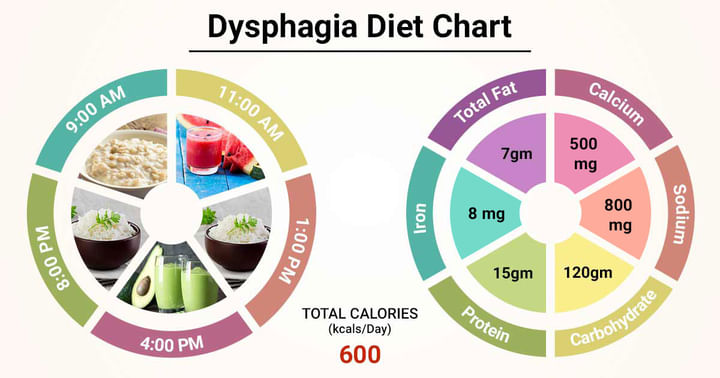Diet Chart For dysphagia
Last Updated: Jan 20, 2025
About
Dysphagia means difficulty with chewing or swallowing food or liquid. To understand how this might happen, it is important to know something about how swallowing occurs. First, food must be chewed thoroughly. Then it is moved to the back of the mouth by tightening the cheek muscles and pressing the tongue against the roof of the mouth. From this point on the process becomes automatic — it is a reflex that people do not actively control. In “rapid- fire” succession, the soft palate closes the nasal airway to prevent food from backing into it, the airway into the lungs is closed, and the esophagus (food pipe) relaxes allowing food and liquid to enter it. The muscular esophagus then contracts in a wave-like action, sweeping the food along into the stomach. fluid can be thickened to make it easier to swallow. However, close monitoring by the dysphagia team is required for anyone drinking less than 4 cups of thickened fluid a day or anyone not progressing to thin liquids within 4 weeks.
The greater problem for some patients is eating enough calories. The whole process of eating simply becomes too difficult and too tiring. However, calorie and protein intake can be increased by fortifying the foods the patient does eat. Food can be ground/diced into 1/4-inch pieces, crushed potato, tomato, pudding, ice-cream and Lemonade and Oatmeal can be eaten.
Diet Chart
| Sunday | |
| Breakfast (8:00-8:30AM) | 1 cup oats with milk porridge |
| Mid-Meal (11:00-11:30AM) | 1 glass of water melon juice |
| Lunch (2:00-2:30PM) | 1 cup of mashed parboiled rice + 1/2 cup mashed tomato dal+ 1/2 cup mashed lauki curry+ 1 glass butter milk |
| Evening (4:00-4:30PM) | 1 glass of thick avocado (75gm) milkshake (milk-150ml) |
| Dinner (8:00-8:30PM) | 1 cup mashed parboiled rice+ 1/2 cup mashed bhindi curry+ 1/2 cup curd |
| Monday | |
| Breakfast (8:00-8:30AM) | 2 slices of whole wheat bread dipped in 1.5 glass of milk |
| Mid-Meal (11:00-11:30AM) | 1 orange peeled |
| Lunch (2:00-2:30PM) | 1 cup of mashed parboiled rice + 1/2 cup mashed mango dal+ 1/2 cup mashed mushroom curry+ 1 glass butter milk |
| Evening (4:00-4:30PM) | 1/2 cup of moong dal soup of thick consistancy |
| Dinner (8:00-8:30PM) | 1 cup mashed parboiled rice+ 1/2 cup mashed bitter gourd curry+ 1/2 cup curd |
| Tuesday | |
| Breakfast (8:00-8:30AM) | 3 mashed sambhar idly |
| Mid-Meal (11:00-11:30AM) | 100 gm of pureed muskmelon |
| Lunch (2:00-2:30PM) | 1 cup of mashed parboiled rice + 1/2 cup mashed carrot dal+ 1/2 cup mashed chicken curry+ 1 glass butter milk |
| Evening (4:00-4:30PM) | 1 glass of thick almond (10 powdered) milkshake (milk-150ml) |
| Dinner (8:00-8:30PM) | 1 cup mashed parboiled rice+ 1/2 cup mashed snake gourd curry+ 1/2 cup curd |
| Wednesday | |
| Breakfast (8:00-8:30AM) | 1 cup blended khichdi |
| Mid-Meal (11:00-11:30AM) | 1 glass of grape juice |
| Lunch (2:00-2:30PM) | 1 cup of mashed parboiled rice + 1/2 cup mashed palak dal+ 1/2 cup mashed rajmah curry+ 1 glass butter milk |
| Evening (4:00-4:30PM) | 1/2 cup of blended chicken stew |
| Dinner (8:00-8:30PM) | 1 cup mashed parboiled rice+ 1/2 cup mashed ivy gourd curry+ 1/2 cup curd |
| Thursday | |
| Breakfast (8:00-8:30AM) | 1 cup corn flakes with milk |
| Mid-Meal (11:00-11:30AM) | 1 glass of apple juice |
| Lunch (2:00-2:30PM) | 1 cup of mashed parboiled rice + 1/2 cup clear samhar+ 1/2 cup mashed matar paneer curry+ 1 glass butter milk |
| Evening (4:00-4:30PM) | 1/2 cup of beetroot and carrot soup of thick consistancy |
| Dinner (8:00-8:30PM) | 1 cup mashed parboiled rice+ 1/2 cup mashed raw banana curry+ 1/2 cup curd |
| Friday | |
| Breakfast (8:00-8:30AM) | Dalia upma (well cooked ) blended with 1 cup sambhar/rasam |
| Mid-Meal (11:00-11:30AM) | 1 glass banana milkshake |
| Lunch (2:00-2:30PM) | 1 cup of mashed parboiled rice 1/2 cup mashed fish curry+ 1/2 cup rasam+ 1 glass butter milk |
| Evening (4:00-4:30PM) | 1 glass of thick walnut milkshake |
| Dinner (8:00-8:30PM) | 1 cup mashed parboiled rice+ 1/2 cup mashed cabbage with coconut milk curry+ 1/2 cup curd |
| Saturday | |
| Breakfast (8:00-8:30AM) | 1 cup of ragi malt with milk of thick consistancy |
| Mid-Meal (11:00-11:30AM) | 1 glass of pomegranate juice |
| Lunch (2:00-2:30PM) | 1 cup of mashed parboiled rice + 1/2 cup mashed drumstick leaves dal+ 1/2 cup mashed egg curry+ 1 glass butter milk |
| Evening (4:00-4:30PM) | 1/2 cup of palak and corriander soup of thick consistancy |
| Dinner (8:00-8:30PM) | 1 cup mashed parboiled rice+ 1/2 cup mashed green peas and tomato curry+ 1/2 cup curd |
Food Items To Limit
- Dry or tough meats : Hot dogs, Bacon, Sausage links, Beef tips, Peanut butter, Cubed cheese, cheese slices, Non-pureed fried, scrambled, or hard-cooked eggs, Nuts, Seeds.
- Starches, Breads & Cereals : Bread or bread products, Bagels, dinner rolls, Pizza, Rice, Granola, Cold cereal, Crispy, fried food, Popcorn, Crackers & Chips.
- Fruits : Raw, whole fruits, Dried fruits, Pineapple, oranges, or other stringy, high pulp fruit.
- Vegetables : Raw, whole vegetables, Salads
- Soups : Soups with chunks of meat or vegetables
- Deserts : Hard cookies, Hard candy, Chewing gum, Chewy candy or desserts
- Olives, Pickles
Do's And Dont's
- Consume a wide variety of foods to ensure your body gets essential nutrients.
- Eat small, frequent meals.
- Chew small bits- large bits may be difficult to swallow.
- Eat both hot and cold foods to provide a variety of temperatures in the diet.
- Sit the Patient in An upright, Erect Position: Sit the patient in a way that he/she is upright in an erect position. If unable to position themselves, you can prop them up with a few pillows.
- Patient Should be Positioned Head Tilted Forward/Chin Down: Assist the patient to tilt their head forward with their chin in a slightly forward position. It helps open the passage down to the oesophagus, unlike the head tilted back position which makes swallowing more difficult.
- Place food in the Stronger Side of the Mouth: If the patient has a facial weakness, be sure to place food onto the stronger side of the mouth. This is especially important as it will not only allow for maximum feeding, but also improve safety during feeding.
- Add more Support to the Impaired Side of the Patient’s Body: If one side of the patient’s body is weaker than the other, be sure to support the weaker side during feeding. This will make it much easier for the force of gravity to bring food bolus downward and pass through the impaired side with great ease.
- Position Yourself at or Below your Patient’s Eye Level: Sitting at or slightly below the patient’s eye level will make it easier for him/her for keep and maintain their head in the best feeding position and also allow them to feed much more comfortably.
Food Items You Can Easily Consume
- Thinned cooked cereals
- Pureed meats, fish, and poultry
- Pureed scrambled eggs and cheese
- Baby cereals
- Pureed ham, tuna, and chicken salad
- Pureed vegetables(avoid peas and corn)
- Mashed potatoes
- Pureed candled sweet potatoes
- Decaffeinated Coffee/Tea
- Ice cream
- Pureed fruits
- Thick milkshakes
- Plain yoghurt
- Cream
References
- National Dysphagia Diet Task Force, American Dietetic Association. National dysphagia diet: Standardization for optimal care. American Dietetic Associati; 2002 [Internet]. books.google.co.in. [Cited 01 July 2019]. Available from:
- Pardoe EM. Development of a multistage diet for dysphagia. Journal of the American Dietetic Association. 1993 May 1;93(5):568-71. [Cited 01 July 2019]. Available from:
- McCullough G, Pelletier C, Steele C. National dysphagia diet: What to swallow?. The ASHA Leader. 2003 Nov;8(20):16-27. [Cited 01 July 2019]. Available from:
Table of content
Find Dietitian/Nutritionist near me
Ask a free question
Get FREE multiple opinions from Doctors



